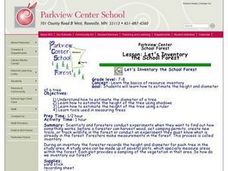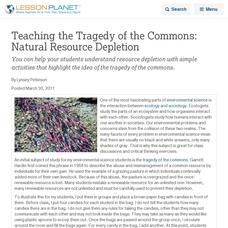San Bernardino Co. Supt. of Schools
Was Julius Caesar a Good Leader for Rome?
Learners consider the various perspectives that different groups in Roman society may have had for Julius Caesar, such as Roman soldiers, senators, the working class, and slaves. The primary activity involves a reading of Caesar's...
Curated OER
The Ebb-Tide
Students study "The Ebb-Tide", an original drama based on the novel by Robert Louis Stevenson."The Ebb-Tide", like many of Stevenson's works, is a nautical adventure combining mystery, murder and memorable char
Curated OER
FLY HIGH!!!
Students create their own bird study in their own schoolyard using the scientific method (see Testing a Hypothesis in Join the Project). Students do research in the library, at a local college, or on the Internet to determine the...
Curated OER
Cool Lights
Students investigate how and why deep-sea organisms produce light. They examine how these processes can be used to study deep ocean environments.
Curated OER
Deadly Roots?
Students examine the roots of various plants. They study and discuss the cross section of a root. They compare different plants with their root systems and complete a worksheet, giving the function/importance of each root part.
Curated OER
Cows in Crisis
Pupils study mad cow disease and how it has affected the lifestyles of many Europeans. They examine local cattle industry and look for steer- or cow-related products. They organize information they find and present it to the rest of the...
Curated OER
The Cultures of Africa
Second graders study the people of Africa, the animals of Africa, and the customs and traditions of the African people. Song and dance are a central part of the African culture, therefore the focus is primarily on those two aspects. They...
Curated OER
Mesozoic Era in Arkansas
Eighth graders study the geology of Arkansas from 225 million years ago to 65 million years ago. They discover they types of strata laid down by the Gulf of Mexico. They examine the economic importance to the community.
Curated OER
Our Schoolsyard is Full of Biology
Students study the habitats found in their schoolyard. They apply firsthand, what they have learned in the classroom to something familiar to them. Students look at biotic, abiotic habitats. Small groups will present their findings to...
Curated OER
Ecological Organization
Young scholars examine the concepts in the ecological organization unit. In this ecological lesson students explore news articles that have to do with the study of ecology.
Curated OER
How Do Weather Conditions and Lunar Cycles Affect Fishing Success?
Students use weather measuring devices to record and study weather conditions at different locations, during different times. They attempt to draw conclusions about the relationship between weather conditions, lunar cycle and fishing...
Curated OER
Be the Kiwi: What is going on in New Zealand?
Students study the three environmental issues facing New Zealand today. In this ecology lesson, students brainstorm some solutions to these environmental issues. They share what they have written in their journals.
Curated OER
LET'S INVENTORY THE SCHOOL FOREST
Students study how to estimate the diameter of a tree, estimate the height of the tree using shadows, estimate the height of the tree using a ruler, and use tools for measuring trees.
Curated OER
Archeological Pow-Wow
Young scholars, in groups, examine the use of artifacts and fossils to study people, plants and animals from the past.
Curated OER
Climate in the Western Regions
Learners examine the interactions of the Earth's systems and other objects in space. In this climate change lesson students study the pros and cons of different climates and what their preferences are.
Curated OER
Diversity of Life
Students study the classification of viruses and describe their structure. In this investigative lesson students complete an activity and answer questions about viruses.
Curated OER
Development of Industrial New Hampshire
Students work in groups to research and share information about several different topics that were part of the development of Industrial New Hampshire. Students complete five parts of the project which include researching, role playing...
Curated OER
Parachute - Land and Weather
Learners use different parachute activities to study weather and land patterns and formations. Tornados and hurricanes can be discussed as students make large waves (move from very high to very low) that mimmick these two weather...
Curated OER
Bubble and Boyle
Even middle schoolers still enjoy experimenting with bubbles! They execute a series of experiments enabling them to distinguish between convex and concave surfaces, explore the properties of buoyancy, surface tension, and density,...
NOAA
Importance of Deep-Sea Ecosystems – What Killed the Seeds?
Most drugs used today come from nature, so the discovery of new ecosystems in the deep sea is exciting from a medical perspective. Scholars develop their own bioassay to test germination rates in seeds.
Consortium for Ocean Science Exploration and Engagement (COSEE)
Arctic Smorgasbord
Though the walrus spends roughly one third of its time on land, it eats organisms that live on the bottom of the ocean. The first in a series of five, the lesson uses a variety of plant and animal cards to have scholars build an arctic...
Curated OER
Teaching the Tragedy of the Commons: Natural Resource Depletion
You can help your students understand resource depletion with simple activities that highlight the idea of the tragedy of the commons.
Howard Hughes Medical Institute
Using DNA to Explore Lizard Phylogeny
In a fun and interactive two-day lesson, learners sort anole lizard pictures by appearance. Next, they watch a video about the anoles and re-sort based on the information in the video. In addition to physical characteristics, budding...
Curated OER
Comparing Theories: Lamarck and Darwin
Learners compare the evolution theories of Lamarck and Darwin. They use self-assessment and a video to increase their knowledge of evolution theories. They research questions and present them to the class.























